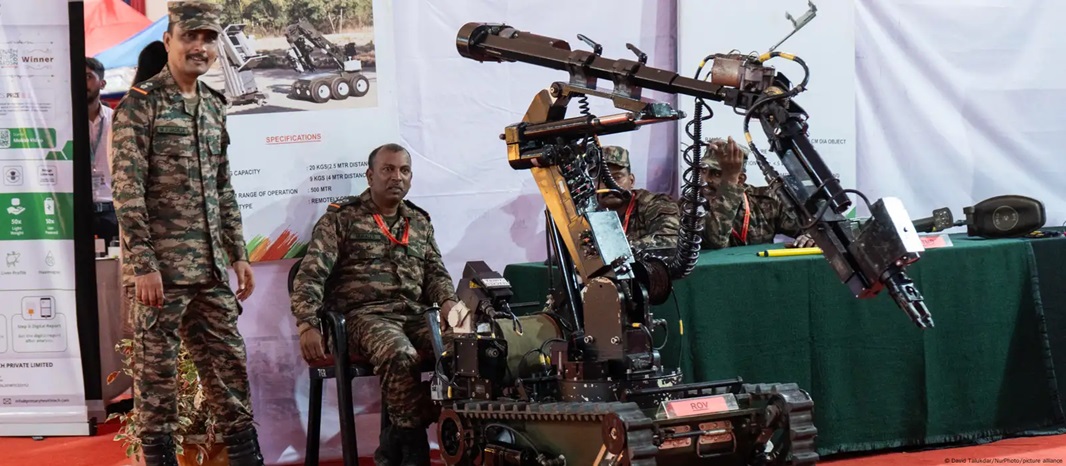With technological progress in the security arena globally, the Indian Army has adopted several Artificial Intelligence (AI)-based Intelligence, Surveillance, and Reconnaissance (ISR) capabilities, significantly enhancing its operational preparedness by integrating cutting-edge technologies into various operations domains.
For improved surveillance and threat detection, AI-powered drones and satellite systems are utilised for real-time intelligence gathering, which enables faster decision-making and preparedness.
These systems provide early warnings, detect intrusions, and classify targets along sensitive and active borders like the Line of Control (LoC) and Line of Actual Control (LAC).
One of the reasons that militaries worldwide have started adopting AI-driven technologies is their ability to process vast amounts of surveillance data in real time and improve situational awareness in challenging terrains.
AI systems come in handy to analyse patterns to predict potential threats for operational forecasting and strategic planning. The data that they compile and send to the forces can help determine the operational gaps of the adversarial force.
With advanced reconnaissance missions, the risks faced by personnel are limited.
The Indian Army has integrated AI across various domains to enhance operational efficiency and preparedness. Technology has benefitted the force by creating realistic battlefield scenarios for training and improving readiness for unpredictable combat environments.
Autonomous systems induced with AI, such as swarm drones can carry out precision strikes in coordination.
To advance the use of AI technology for operational defence purposes, the Indian Ministry of Defence established a task force in February 2018 to examine the prospective implementation of AI in defence.
Under the ‘Strategic Implementation of Artificial Intelligence for National Security and Defence’, the task force submitted recommendations, based on which, in 2019, a Defence AI Project Agency (DAIPA) and a Defence AI Council (DAIC) were established.
While the DAIC provides policy-level oversight, DAIPA focuses on operational execution and project management. The idea behind forming these bodies is to position India as a global leader in AI-driven defence capabilities.
Moreover, in 2022, the defence minister launched 75 Artificial Intelligence products and technologies during the first-ever ‘AI in Defence’ symposium & exhibition in New Delhi.
These AI applications included platforms under broad categories such as automation, autonomous systems, blockchain-based automation, command and control systems, cybersecurity, human behavioural analysis, intelligent monitoring, lethal autonomous weapons, logistics and supply chain management, operational analytics, manufacturing and maintenance, simulators/test equipment, and speech/voice analysis using natural language processing.
Moreover, India is collaborating with the United States for an ‘Advanced Domains Defense Dialogue’—emphasising evolving technological domains in defence such as artificial intelligence.
While these steps are a whole-of-government effort, the Indian Army, on its part, has also taken steps for AI integration into the operations of the force. In its blueprint for the ‘Year of Reforms’, the Indian Army has harnessed new domains such as cyber, space, and artificial intelligence.
It also mentioned its willingness to adopt AI, machine learning (ML), hypersonic technology, and robotics solutions. Towards this end, the Army is considering the creation of specialised units to leverage niche technologies and newer domains.
Under the Corps of Signals, headed by a Colonel rank officer, the Army has also formed the Signals Technology Evaluation and Adaptation Group (STEAG) consisting of 280 personnel for research and evaluation of futuristic communication technologies such as AI, 5G, 6G, ML, and quantum technologies for defence applications, which is an effort towards its motto of “on path to transformation”.
The Indian Army also uses AI-based software—AGNI D for surveillance. This technology has been deployed along the country’s northern border with China.
The Military College of Telecommunication Engineering (MCTE) has evolved into an AI research and development hub. Innovations like the Situational Awareness Module for the Army (SAMA) and advanced pattern recognition software for satellite imagery analysis.
For cutting-edge, data-driven solutions, the Indian Army has also come up with AI Incubation Centre (IAAIIC). It is aimed at becoming the hub for innovation and collaboration in the AI domain, promoting R&D, indigenous capacity, talent building, and operational edge. It has been learnt that the Army has more than 50 AI projects actively under development.
The Indian Army has established cells at the Indian Institute of Technology Delhi (IIT-D), IIT Kanpur, and the Indian Institute of Science (IISc) Bengaluru, and some of the notable contributions have taken place in areas such as AI, Robotics and Electric Vehicles (EVs).
The Army is also actively working on integrating predictive analytics and AI-driven decision support platforms across operational and administrative domains.
Moreover, the Army is also adopting AI-driven simulations to create realistic battlefield scenarios for personnel training and enhance readiness for unpredictable combat environments.
Aritra Banerjee is a military author and defence and security columnist.

